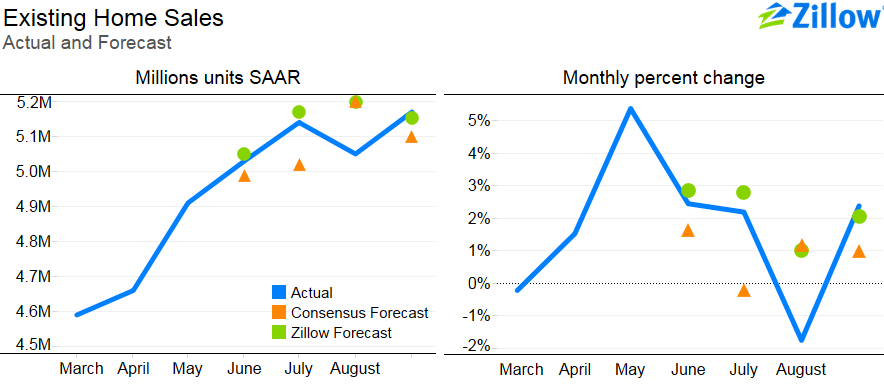Existing home sales totaled 5.17 million units (SAAR) in September, up 2.4 percent from August
- Zillow predicted existing home sales to rise 2.1 percent from August, to a seasonally adjusted annual rate (SAAR) of 5.15 million units.
- Most analysts expected flat results, with a consensus forecast of 5.1 million units (SAAR), up 1.0 percent from August.
September was the strongest month for existing home sales in a year
- The volume of existing home sales had been trending downward, even as low interest rates meant that homes remain very affordable. Low sales volume can be attributed to:
- Lack of inventory, particularly at the low end of the market. Inventory is up year-over-year, but remains well below normal levels. Entry level homes are particularly hard to find, as many have been scooped up by investors in recent years or are being kept off the market because their owners are underwater and cannot sell.
- Changing demographics. Younger home buyers are waiting longer to get married and have children, which is delaying their home purchases. The majority of an expert panel of more than 100 economists nationwide sponsored by Zillow said they expected the median age of first-time homebuyers to rise in coming years.
- Difficulty finding good, full-time jobs with quality wages. Wage growth among would-be younger homebuyers is stagnant, making it difficult to save up for a home.
- The fact that sales volume is picking up is encouraging. It means that buying conditions are easing somewhat, and the market is getting back to basics.
Median sales price of existing homes sold in September was $209,000, up 0.6 percent from August and up 5.7 percent from last year
- The median sale price of existing homes grew at 5.7 percent year-over-year in September, half the 11.4 percent pace recorded in September 2013.
- Home value growth has also slowed. Zillow’s median home value grew at an annual pace of 6.6 percent in August, down from a 7.6 percent annual pace in May.
- The homeownership rate has been hovering around near-20-year lows, but likely increased over the summer as there were strong existing and new home sales and a falling vacancy rate.
Based on our structural model of existing home sales, the homeownership rate likely picked up over the summer
- The homeownership rate has been hovering around near-20-year lows, but likely increased over the summer as there were strong existing and new home sales and a falling vacancy rate.
